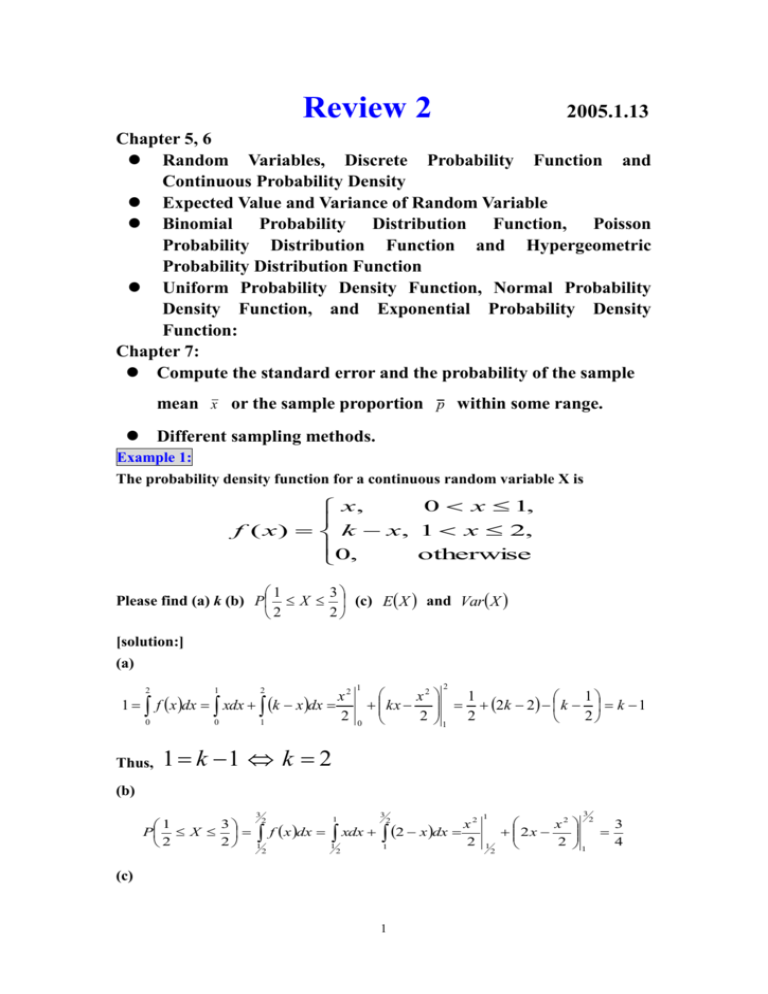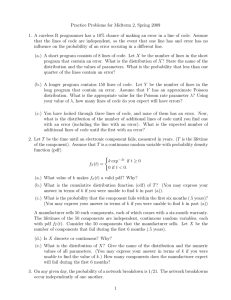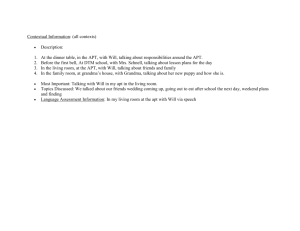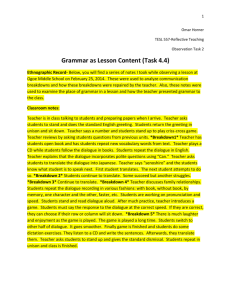Review 2 2004
advertisement

Review 2 2005.1.13 Chapter 5, 6 Random Variables, Discrete Probability Function and Continuous Probability Density Expected Value and Variance of Random Variable Binomial Probability Distribution Function, Poisson Probability Distribution Function and Hypergeometric Probability Distribution Function Uniform Probability Density Function, Normal Probability Density Function, and Exponential Probability Density Function: Chapter 7: Compute the standard error and the probability of the sample mean x or the sample proportion p within some range. Different sampling methods. Example 1: The probability density function for a continuous random variable X is 0 x 1, x, f ( x ) k x, 1 x 2, 0, otherwise 3 1 Please find (a) k (b) P X (c) E X and Var X 2 2 [solution:] (a) 2 1 0 Thus, 1 2 x2 f x dx xdx k x dx 2 0 1 1 0 2 x2 1 1 kx 2k 2 k k 1 2 1 2 2 1 k 1 k 2 (b) 3 1 P X 2 2 3 2 1 2 1 3 x2 f x dx xdx 2 x dx 2 1 1 2 2 (c) 1 3 1 1 2 2 x2 3 2 x 2 1 4 2 1 2 x3 E X xf x dx x dx x2 x dx 3 0 0 1 1 2 0 2 x3 x 2 1 . 3 1 Since E X2 1 2 2x3 x 4 x4 7 x 2 f x dx x 3 dx x 2 2 x dx , 4 0 3 4 1 6 0 0 1 2 1 2 Var X E X 2 2 7 1 12 . 6 6 Example 2: Twenty percent of the applications received for a particular position are rejected. What is the probability that among the next fourteen applications, (a) none will be rejected? (b) all will be rejected? (c) less than 2 will be rejected? (d) more than one will be rejected? (e) Determine the expected number of rejected applications and its variance. [solution:] Let X represent the number of rejections among the next fourteen applications. Then, the distribution function of X is n 14 n i f i p i 1 p (0.2) i (0.8)14i , i 0,1,,14; i i 14 0.20 0.814 0.814 0.044 P X 0 f 0 (a) 0 14 0.214 0.80 0.214 0 P X 14 f 14 (b) 14 (c) P X 2 P X 0 P X 1 f 0 f 1 14 1 13 0.044 0.2 0.8 0.044 14 0.2 0.055 1 0.1979 (d) P X 1 1 P X 1 1 P X 0 P X 1 1 0.1979 0.8021 by (c) 2 (e) E X np 14 0.2 2.8, Var X np1 p 14 0.2 0.8 2.24 Example 3: A new automated production process has been averaging 2 breakdown per 8 hours of operation. Assume the number of breakdowns follows a Poisson probability distribution. (a) What is the mean time between breakdown and the distribution for the time between breakdowns? (b) What is the probability that the process will run one hour or more before another breakdown? (c) What is the probability that the process can run a full 8-hour shift without a breakdown? [solution:] (a) 2 1 1 0.25 breakdown/ hour 4 hour/break down . 8 0.25 Then, the time between breakdowns is exponentially distributed with probability density function f x 1 x 1 e 4 e x 4 . (b) [method 1:] Let Y be the random variable representing the time between breakdowns with exponential probability density. 1 PY 1 e e 1 4 0.7788 . [method 2:] Let X be the random variable representing the number of breakdowns within 1 hour. Then, P X 0 e 0 0! e 0.25 0.7788 (c) [method 1:] 8 PY 8 e e 8 4 3 e 2 0.1353 . [method 2:] Let S be the random variable representing the number of breakdowns within 8 hour. Then, 0.25 8 2 breakdown/ 8 hour . PS 0 e 0 0! e 2 0.1353 Example 4: Let X ~ N 6,5 2 . Compute (a) P6 X 12 (b) P X 6 5 (c) P X 2 9 (d) P X 0 . [solution:] Since X ~ N 6,5 2 , then (a) X 6 Z ~ N 0,1 . 5 6 6 X 6 12 6 P6 X 12 P P0 Z 1.2 0.3849. 5 5 5 (b) X 6 5 P X 6 5 P P Z 1 P 1 Z 1 2 P0 Z 1 5 5 2 0.3413 0.6826 (c) 36 X 6 36 P X 2 9 P 3 X 3 P P 1.8 Z 0.6 5 5 5 P0.6 Z 1.8 P0 Z 1.8 P0 Z 0.6 0.4641 0.2257 0.2384 (d) X 6 06 P X 0 P PZ 1.2 PZ 1.2 5 5 PZ 0 P0 Z 1.2 0.5 0.3849 0.1151 Example 5: A bank has kept records of the checking balances of its customers and determined that the average daily balance of its customers is $300 with a standard deviation of $48. A random sample of 144 checking accounts is selected. a. What is the probability that the sample mean will be more than $306.60? b. What is the probability that the sample mean will be less than $308? c. What is the probability that the sample mean will be between $302 and 4 $308? d. What is the probability that the sample mean will be at least $296? e. How large of a sample needs to be taken to provide a 0.4015 probability that the sample mean will be between $300 and $304? [solution:] 48 Since X 4, 300, , n 144 (a) P306.6 X 306.6 300 X X 300 P 4 4 X P1.65 Z 0.5 P0 Z 1.65 0.5 0.4505 0.0495 (b) PX 308 X X 300 308 300 P 4 4 X PZ 2 0.5 P0 Z 2 0.5 0.4772 0.9772 (c) P302 X 308 302 300 X X 300 308 300 P 4 4 4 X P0.5 Z 2 P0 Z 2 P0 Z 0.5 0.4772 0.1915 0.2857 (d) P296 X 296 300 X X 300 P 4 4 X P 1 Z 0.5 P 1 Z 0 0.5 P0 Z 1 0.5 0.3413 0.8413 5 (e) P300 X 304 300 300 X 304 300 P X X X 4 0.4015 P 0 Z X 4 4 1.29 48 1.29 n 15.48 X 48 4 n n 239.63 n 240 Example 6: In a university, 10% of the students live in the dormitories. A random sample of 100 students is selected for a particular study. (a) What is the probability that the sample proportion (the proportion living in the dormitories) is between 0.172 and 0.178? (b) What is the probability that the sample proportion (the proportion living in the dormitories) is greater than 0.025? [solution:] p 0.1, n 100, P p1 p 0.1 1 0.1 0.03 n 100 np 10 5, n1 p 90 5 (a) 0.172 0.1 P p P 0.1 0.178 0.1 P 0.172 P 0.178 P 0 . 03 0 . 03 0 . 03 P P2.4 Z 2.6 0.0035 (b) 0.025 0.1 P p P 0.1 P0.025 P P 0 . 03 0 . 03 P P 2.5 Z 0.9938 6











